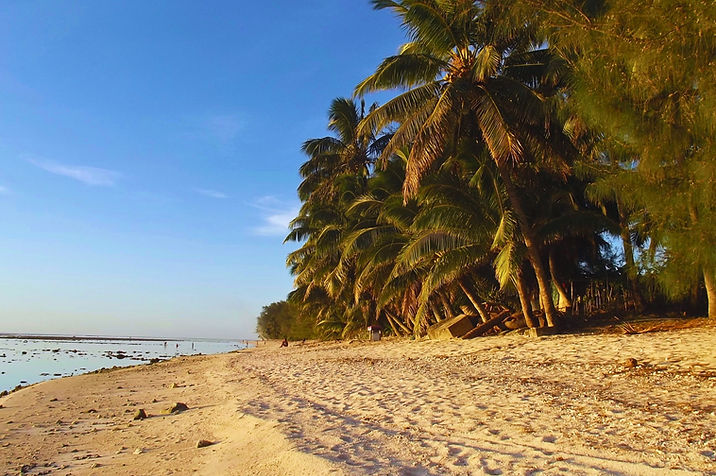
Rarotonga, the largest of the Cook Islands, is a tropical paradise known for its stunning beaches, lush landscapes, and vibrant culture. Located in the South Pacific Ocean, Rarotonga offers a mix of relaxation and adventure. Visitors can explore the scenic Muri Lagoon, the bustling Punanga Nui Market, and the historic Arai-Te-Tonga Marae. With its warm climate, turquoise waters, and welcoming locals, Rarotonga provides an idyllic and unforgettable travel experience.
A Brief History
Rarotonga, the largest of the Cook Islands, has a rich history that dates back to ancient Polynesian settlers. The island's history is deeply rooted in its indigenous culture and traditions, with its people maintaining a strong connection to their ancestral heritage. European explorers arrived in the 18th century, and Rarotonga eventually became a British protectorate in the late 19th century before being incorporated into the New Zealand realm.
Rarotonga's historical landmarks, such as the Avarua town, the Cook Islands Christian Church, and the Highland Paradise Cultural Centre, reflect its rich cultural heritage. The island played a significant role in the regional trade and cultural exchange, with its strategic location making it an important stopover for voyaging canoes. Today, Rarotonga is known for its stunning natural beauty, vibrant cultural scene, and warm hospitality. The mix of historical charm and natural splendour makes Rarotonga a captivating destination for travellers seeking to explore the Cook Islands' heritage.
Rarotonga, Cook Islands
Attractions and Activities
Rarotonga, the largest of the Cook Islands, is known for its stunning beaches, lush landscapes, and vibrant culture. Here are some top attractions and activities:
Muri Beach: A beautiful lagoon with crystal-clear waters, perfect for swimming, snorkelling, and kayaking.
Te Vara Nui Village: A cultural village offering traditional performances, village tours, and authentic Cook Islands cuisine.
Cross Island Track: A scenic hiking trail that takes you through the lush interior of Rarotonga, offering stunning views and a chance to see the iconic Needle rock formation.
Punanga Nui Market: A bustling market where you can find fresh produce, local crafts, and traditional foods.
Aroa Marine Reserve: A protected marine area known for its vibrant coral reefs and diverse marine life, ideal for snorkelling and diving.
Wigmore's Waterfall: A picturesque waterfall surrounded by lush vegetation, perfect for a refreshing swim.
Tikioki Marine Reserve: Another excellent spot for snorkelling, offering clear waters and abundant marine life.
Black Rock Beach: A unique beach with volcanic rock formations and excellent swimming and snorkelling opportunities.
Culture
Rarotonga's culture is deeply rooted in Polynesian traditions, with a strong emphasis on community, music, and dance. The local people, known as Cook Islanders, are warm and welcoming, and they take pride in preserving their cultural heritage. Traditional dance and music are an integral part of life on the island, with performances often held at cultural centres, resorts, and during festivals. The Te Vara Nui Village is a popular cultural attraction where visitors can experience traditional Cook Islands performances, village tours, and authentic Polynesian cuisine.
The local cuisine in Rarotonga is a delightful blend of fresh seafood, tropical fruits, and traditional Polynesian flavours. Some must-try dishes include ika mata (raw fish marinated in coconut milk and lime), rukau (taro leaves cooked with coconut milk), and poke (a dessert made from ripe bananas and coconut cream). The Punanga Nui Market is an excellent place to sample local delicacies and purchase fresh produce. Additionally, many resorts and restaurants on the island offer traditional feasts, known as "umu" or "hangi," where food is cooked in an underground oven.
Rarotonga is also known for its vibrant arts and crafts scene. The island's artisans create beautiful handcrafted items, such as woven baskets, wooden carvings, and traditional tivaevae (quilts). These crafts are often sold at local markets and galleries, making for unique souvenirs and gifts. The island hosts various cultural events and festivals throughout the year, such as the Te Maeva Nui celebrations, which mark the Cook Islands' self-governance day and feature parades, dance competitions, and cultural displays. These events provide a unique opportunity to experience the rich cultural heritage of Rarotonga.
Best Time to Visit
Rarotonga can be visited year-round, but the best time to visit is during the dry season:
Dry Season (May to October): These months offer the most pleasant weather with lower humidity and less rainfall, making it ideal for beach activities and outdoor exploration.
Wet Season (November to April): While the wet season brings higher humidity and occasional rain, it’s also a great time to experience the lush, green landscapes. However, some outdoor activities may be limited due to weather conditions.
Suggested Itinerary
Day 1: Start with a visit to Muri Beach for swimming, snorkelling, and kayaking in the crystal-clear lagoon. In the afternoon, explore the Punanga Nui Market to sample local foods and shop for crafts. In the evening, enjoy a traditional Cook Islands dinner and dance performance at Te Vara Nui Village.
Day 2: Spend the morning hiking the Cross Island Track to see the lush interior and the iconic Needle rock formation. In the afternoon, relax at Aroa Marine Reserve for snorkelling and swimming. End the day with a sunset visit to Black Rock Beach.
Day 3: Take a morning trip to Wigmore's Waterfall for a refreshing swim. In the afternoon, visit Tikioki Marine Reserve for more snorkelling and marine life exploration. In the evening, enjoy a leisurely dinner at a beachfront restaurant.

Local Tips
Transport: Rarotonga has a limited public transport system, with buses running around the island. Renting a scooter, bicycle, or car is recommended for exploring the island.
Currency: The local currency is the New Zealand dollar (NZD). Credit cards are widely accepted, but it’s good to carry some cash for small purchases.
Local Etiquette: Dress modestly when visiting cultural sites and be respectful of local customs. Always greet people with a friendly "Kia Orana" (hello) and a smile.
Travel Tips
Emergency Services: In case of an emergency, dial 999 for police, fire, or medical assistance.
Nearest Hospital: Rarotonga Hospital is the main healthcare facility on the island.
Health: Ensure you are up-to-date with vaccinations and carry any necessary medications. Drink bottled water to avoid stomach issues.
Safety: Rarotonga is generally very safe, but take standard travel precautions and be aware of your surroundings, especially at night.
Commonly Asked Questions
Q: What is the best time of year to visit Rarotonga? A: The best time to visit is during the dry season, from May to October, for pleasant weather and outdoor activities.
Q: What are must-visit attractions in Rarotonga? A: Don't miss Muri Beach, Te Vara Nui Village, Aroa Marine Reserve, and Wigmore's Waterfall.
Q: Is Rarotonga family-friendly? A: Yes, Rarotonga offers numerous family-friendly activities, including beaches, cultural sites, and outdoor adventures.
Q: What are the best outdoor activities in Rarotonga? A: Beach outings, snorkelling, hiking, and exploring waterfalls are popular outdoor activities.
Q: How can I get around Rarotonga? A: Renting a scooter, bicycle, or car is recommended for getting around the island, as public transport is limited.
Rarotonga, with its stunning beaches, rich cultural heritage, and vibrant atmosphere, promises an unforgettable travel experience. Whether you're exploring its beautiful landscapes, indulging in its local cuisine, or immersing yourself in its cultural traditions, Rarotonga offers something for every traveller. Pack your bags and get ready to discover the charm of this captivating island in the Cook Islands!
Happy travels! 🌍✈️












